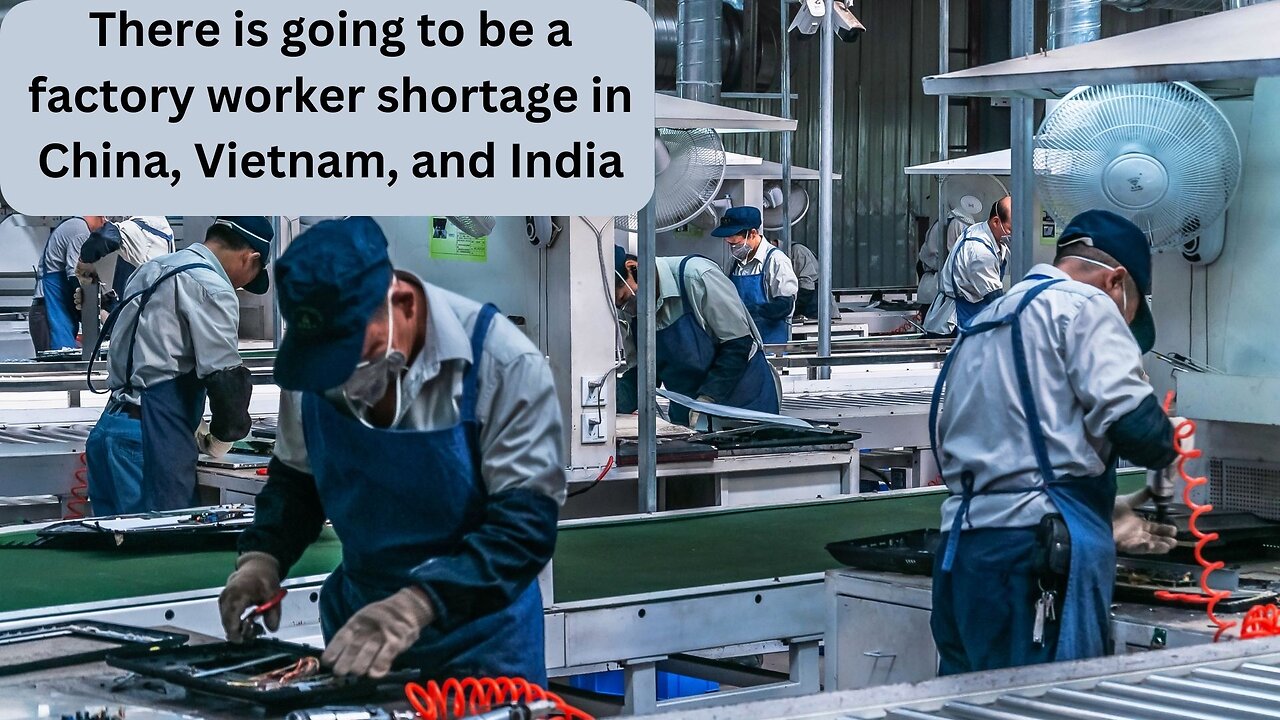Premium Only Content

There is going to be a factory worker shortage in China, Vietnam, and India
There is going to be a factory worker shortage in China, Vietnam, and India
Alarm bells should be ringing at Western companies that rely on inexpensive Asian labor to churn out affordable consumer goods.
Asian countries are rapidly aging. In 2001, Nike reported 80% of factory workers were in Asia with a typical age of 22, single, and raised on a farm. Today, the average worker for Nike in China is 40, and in Vietnam is 31.
There was a time when it was easy to attract labor in Asia.
The globalized manufacturing model has delivered a vast array of inexpensively produced goods to consumers across the world.
We have become accustomed to cheap goods like flatscreens that are manufactured in factories in China and Vietnam. Looking at the Walmart website, I can purchase a 32-inch television for $100 or a 55 inch television for $250. Previously, I did a video that address the question “why is it so expensive to repair consumer appliances.” The answer is that it is not that it is expensive to repair appliances so much as it is extremely cheap to purchase a new appliance. When your fridge or dishwasher breaks, I would reckon that you ultimately decide to just replace the appliance with a new one, rather than paying a repair person.
The garment industry is seeing young workers routinely drop out of training programs. Those that stay will only work in garment factories for a couple of years.
Factories in Asia are being forced to increase wages and adopt costly worker retention strategies. Factories are improving the quality of their cafeterias and are building childcare facilities. Some factories subsidize kindergarten or fund technical-training programs. Other factories are relocating to rural areas were people are more willing to do manual labor, but this puts these factories farther away from ports and suppliers, while also forcing them to accommodate rural life including worker absences during harvest.
Increased labor costs are becoming the rule, rather than the exception, across companies that rely on manufacturing in Asia. In June, Nike reported higher product costs due to labor. Hasbro reported this year that labor shortages in Vietnam and China increased its costs to produce its toys and games. Mattel, the maker of Barbie, is also facing higher labor costs for manufacturing. Both Hasbro and Mattel passed on these higher manufacturing labor costs to consumers in the form of price increases. The trend of increased labor costs being passed onto consumers is a trend that will accelerate in the future because workers in Asia do not want to work in a factory like their parents.
Beginning in the 1990s, Asian manufacturing hubs, most notably China, began to integrate into the global economy. What were previously poor, rural, agricultural societies became the manufacturing center of the world. The price of everything from appliances to furniture drastically fell.
Not only are young people disinterested in factory work, but they are having fewer children than their parents did, and at later ages. These factors mean there is less pressure to earn a steady income in their twenties. The service sector offers less-backbreaking work as a store clerk in a mall and as a receptionist at a hotel.
Urban youth unemployment in China was 21% in June despite factory labor shortages.
Many young people in manufacturing nations are well educated. They believe their lives should not be lived inside the confines of factory walls.
One furniture manufacturing business owner who was interviewed by the Wall Street Journal make furniture for retailers like Lowe’s. The business is call Acacia Woodcraft Vietnam. While the business is partially automated, human craftsmanship is still needed for many tasks. She moved her factory out of southern China four years ago and considered Ho Chi Minh City. She reconsidered this after hearing horror stories about worker turnover and soaring wages. She instead set up a factory in rural northern Vietnam. The typical worker here is in there 40s or 50s. Some can’t read very well so she has to explain things verbally and visually demonstrate tasks as well. However, what we gained in rural northern Vietnam is a stable workforce, something hard to find in southern China or even Ho Chi Minh City. Younger employees that can read well are treasured. The factory owner involves them in decision making and to meet American buyers.
Factory wages in Vietnam have more than doubled since 2011 to $320 a month which is three times the rate of increases in the United States. Factory wages in China has risen 122% from 2012 to 2021.
In the past, when local wages rose too much, manufacturers would typically relocated to a place with more affordable wages. While there are countries in Africa and South Asia with large labor pools, these locations lack political stability, good infrastructure, or trained workforces. Clothing brands that expanded into Myanmar and Ethiopia were disrupted by unrest and civil war. While Bangladesh has been a reliable country to produce clothing in, the country has restrictive trade policies and clogged ports.
While India does have a huge population, issues with retaining young workers that plague China are becoming endemic in India as well. Young people in India prefer either a rural farm life supported by state welfare programs or gig work versus living in factory dormitories in industrial hubs in the cities. India is known for its IT staff, and the IT industry is another draw of workers away from factories.
One Nike supplier has struggled so much to attract young workers that it ended a training program for high school graduates because so few of them were accepting the job afterward. Now, 90% of this Nike supplier’s workforce is 30 or older.
One CEO said that once young Asian people see reality television, they have a desire to work in retail rather than a factory. She is planning to move production to North Carolina and automate it. Perhaps this is a trend we will see: a factory worker in shortage in Asia resulting in companies moving factories to the United States and automating production.
Aging populations in Asian countries also mean more young people are taking care of their elders, instead of working in manufacturing.
Works Cited:
https://www.wsj.com/articles/asia-factories-consumer-goods-labor-prices-7140ab98?mod=hp_lead_pos7
Tags:
china, manufacturing, china manufacturing industry, manufacturing in china, glass manufacturing in china, manufacturing a product in china, made in china, china economy, china manufacturing, chinese manufacturing, china's manufacturing, china manufacturing collapse, china factory, india manufacturing, apple manufacturing in india, vietnam manufacturing, manufacture a product in china, china manufacturing small products, factories in china, factory in china, manufacturing in vietnam, vietnam manufacturing, made in vietnam, manufacturing in vietnam vs china, vietnam, manufacturing vietnam, vietnam manufacturing industry, sourcing in vietnam, sourcing agent in vietnam, vietnam economy, vietnam economic growth, factory in vietnam, pros and cons of manufacturing in vietnam, vietnam sourcing, sourcing from vietnam, why india lags behind vietnam in manufacturing, vietnam investment, how to find suppliers in vietnam
-
 4:21
4:21
The Last Capitalist in Chicago
1 year agoWhat is the Hume-Cantillon Effect?
2521 -
 LIVE
LIVE
Barry Cunningham
2 hours agoPRESIDENT TRUMP MADE TODAY A VERY BAD DAY TO BE A DEMOCRAT!
8,183 watching -
 8:19
8:19
MattMorseTV
6 hours ago $0.90 earnedTrump is ACTUALLY DOING IT.
1.82K17 -
 LIVE
LIVE
ZWOGs
8 hours ago🔴LIVE IN 1440p! - Tarkov w/ Casey & crgoodw1n, Kingdom Come Deliverance, & More - Come Hang Out!
46 watching -
 1:45:02
1:45:02
Glenn Greenwald
3 hours agoIsrael Slaughters More Journalists, Hiding War Crimes; Trump's Unconstitutional Flag Burning Ban; Glenn Takes Your Questions | SYSTEM UPDATE #504
68K60 -
 LIVE
LIVE
Killerperk
34 minutes agoRoad to BF6. Come hang out #regiment #bf6
69 watching -
 LIVE
LIVE
Jokeuhl Gaming and Chat
1 hour agoDARKTIDE - Warhammer 40k w/ Nubes Bloobs and AoA
31 watching -
 LIVE
LIVE
Cripiechuccles
2 hours ago😁💚💙MOTA MONDAY WITH CRIPIE💚💙 👌SMOKING, GAMING & WATCHING FLICKS!:😁
58 watching -
 DVR
DVR
Stephen Gardner
1 hour ago🔥'Burn ALL TRUMP FLAGS’ says Tim Walz + Democrat CAUGHT rigging own election!
2192 -
 10:10
10:10
robbijan
1 day agoHollywood’s Hidden Messages: Predictive Programming & What’s Next
1.13K8